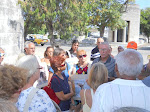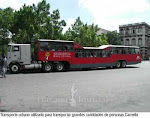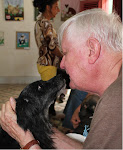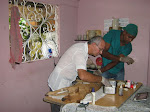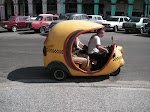Starving Lion
The word "emaciated" did not begin to describe the lion--you could see every rib, and he looked sick, tired, and old, not the king of the jungle he was meant to be. He paced along his enclosure, and a sympathetic tourist snapped his pictures. That tourist felt the lion was being abused and sent the pictures to PETA, the wonderful animal rights group in Norfolk, VA. On December 4th the matter came to me, and I was asked to see if we could help the lion through Aniplant, Nora Garcia's animal protection organization in Havana. Of course we had to try.
As it turned out, the zoo was in Santiago de Cuba, 500 miles from Havana at the extreme eastern end of the island. It couldn't have been farther away. But distance is no obstacle for Nora, who has animal friendly connections in all parts of Cuba. My contact at PETA was Stephanie Bell, their manager of cruelty investigations, and the nearly two months it took to resolve the matter seemed like an eternity to both of us.
Nora, in the meantime, got a report on the lion from a local supporter. As it happened, Aniplant was forming an investigative committee to evaluate conditions at zoos across the country. She used Aniplant's position as the only officially permitted animal protection organization, and her new committee to bring the lion's plight to the attention of powerful officials in the area.
Nora quietly pressed forward with a plan to help the lion, while Stephanie and I woke up each morning hoping the lion had not died. His picture surely looked like he was at death's door. On January 24 we got Nora's report, which I'll let speak for itself:
Dear Les,
Now we can report on the lion--at least the real information we got from the new director of the zoo.
The lion is timid, fearful, frightened, and did not have adequate attention, and as a result, its two companions ate while he hardly did.
This situation was not treated nor solved by the Park Director, and there were many complaints about the poor animal.
The intervention of the Party Director in that province (a high official) and the Popular Power and the Minister of Environment (another high official) and of course of Aniplant was achieved.
Solution: The old Director of the Park who had been there 30 years was fired, and his duties spread to other employees.
The lion is very young, hardly one year old, is now isolated and is eating alone. He's receiving vitamins and minerals (in short supply in Cuba) and he has gained some weight, judging by recent photos. He isn't on exhibition. He's not sick, but he is recovering.
The current Director, appointed only a week ago, is named Kenia Ortíz Reyes, a graduate in Social Communication and she has lots of motivation and compassion.
There are 13 lions in the zoo including the timid one, 2 black and one brown bear, and a rhinoceros. A hippo died a short time ago of something he ate--bad digestion. There are also birds, and other smaller animals.
The Park Director appreciates the interest shown and hopes for collaboration and help to improve conditions for the animals.
We are well connected with the Director and she and I phone each other often.
Whatever additional information won't have such a delay--it will be very rapid.
I hope you and Charlene and Stephanie understand the wait and that you understand my report.
A hug and kiss,
Nora
Les' note: I love happy endings
Friday, January 28, 2011
Friday, January 14, 2011
Street Animals
Street Animals
Animal lovers who travel to Cuba usually spot homeless dogs on the streets. They often are pitiful, emaciated, and sick. It's only natural to want to save them and even adopt them.
Thus (TAP) and Aniplant often get requests to find and rescue a given dog, get it healthy, and then ship it to a new home in the US or Canada. Usually these requests come via email from the travelers after they've returned home. We try to help when we can, but this is a very inefficient use of our resources and those of the traveler.
First of all, street dogs aren't always easy to find. They often keep moving in search of anything they can eat. Also, usually they are sick. If we are lucky enough to find an animal, we have to find a foster home for it, get vet treatment and inoculations, await some test results, coordinate with airlines, buy a travel carrier (at inflated tourist prices), travel to the airport, and coordinate all this (with translations) via email with the new adoptive family. If needed, travel to other cities away from Havana means renting a car, hotel stays, etc. The traveler must bear all of these costs.
A far more efficient approach is to leave the street dog in Cuba and visit an animal shelter near your home for your new companion. You'll find a large variety of healthy animals (more than 30% are purebred, if you want a specific type), and very reasonable costs.
We certainly hate to pass by those poor sick animals we see on the street, but we must keep our eye on our objective, which is to spay and neuter as many animals in Cuba as possible. Ultimately this is the only practical wayto address overpopulation of dogs and cats in any locality. We are not being cruel when we resist out-of-country adoptions--we're merely addressing their plight in a more effective, although longer term, way.
But if you have your heart set on bringing an animal home with you, plan ahead. Travel with a pet carrier, and plan to be there at least 7 days after getting the dog for vet work and tests, and arrange to fly your new friend on the same plane you use to return home. It will be expensive and demanding, but we all know how hard it is to try to put those sad, skinny creatures out of your mind and keep on walking. Rescue one if you must, but understand how much it will really require in cost, time, and effort.
Les Inglis
Animal lovers who travel to Cuba usually spot homeless dogs on the streets. They often are pitiful, emaciated, and sick. It's only natural to want to save them and even adopt them.
Thus (TAP) and Aniplant often get requests to find and rescue a given dog, get it healthy, and then ship it to a new home in the US or Canada. Usually these requests come via email from the travelers after they've returned home. We try to help when we can, but this is a very inefficient use of our resources and those of the traveler.
First of all, street dogs aren't always easy to find. They often keep moving in search of anything they can eat. Also, usually they are sick. If we are lucky enough to find an animal, we have to find a foster home for it, get vet treatment and inoculations, await some test results, coordinate with airlines, buy a travel carrier (at inflated tourist prices), travel to the airport, and coordinate all this (with translations) via email with the new adoptive family. If needed, travel to other cities away from Havana means renting a car, hotel stays, etc. The traveler must bear all of these costs.
A far more efficient approach is to leave the street dog in Cuba and visit an animal shelter near your home for your new companion. You'll find a large variety of healthy animals (more than 30% are purebred, if you want a specific type), and very reasonable costs.
We certainly hate to pass by those poor sick animals we see on the street, but we must keep our eye on our objective, which is to spay and neuter as many animals in Cuba as possible. Ultimately this is the only practical wayto address overpopulation of dogs and cats in any locality. We are not being cruel when we resist out-of-country adoptions--we're merely addressing their plight in a more effective, although longer term, way.
But if you have your heart set on bringing an animal home with you, plan ahead. Travel with a pet carrier, and plan to be there at least 7 days after getting the dog for vet work and tests, and arrange to fly your new friend on the same plane you use to return home. It will be expensive and demanding, but we all know how hard it is to try to put those sad, skinny creatures out of your mind and keep on walking. Rescue one if you must, but understand how much it will really require in cost, time, and effort.
Les Inglis
Friday, January 7, 2011
Cuba's Strays
Cuba's Strays
After Cuba the Dog flew from Cuba to Toronto, his new best friend, Ashley, talked to a couple of reporters, and suddenly Cuba was in the news. Newspaper and magazine articles told locals of the lucky little puppy from a roadside zoo near Holguin, Cuba who was so cute that Ashley fought to find a way to rescue him and ship him to her in Canada. It was a story with a happy ending.
But for every Ashley who visits Cuba, there are hundreds of tourists who go there, see pitiful dogs on the streets in distress and go home resigned to the hopelessness of it all. Of course it isn't just Cuba. In some third world countries the dogs have it even worse. But we're here to tell Cuba stories, and, regarding stray dogs on the street, there is much to talk about.
Rachel had been to Viñales on the north coast in the western part of Cuba. She didn't focus on a particular dog, but commented on their generally poor condition--ribs showing, skin in terrible condition. And they looked desperate and hopeless. Some say animals have no human emotions, but real animal lovers can see the stress in their faces.
Rachel suggested that perhaps tour guides should be working to help the strays because the sight of them is a downer for their clients, the tourists. Well, interestingly we had that idea come up before. Juan was a tour guide on a tour bus that ran from Havana to the Cuban city of Trinidad. At a rest stop, Peggy spotted a hungry stray dog and gave her lunch to her. She befriended Juan thinking that she might have his help in finding the dog later and in sending it to her in Massachusetts.
With a little detective work and the Internet, Nora found Juan and learned the number of the room in a Havana hotel where he stayed between bus trips. When she finally got him on the phone, he made it clear he couldn't be bothered helping a dog. Why had he been so friendly with Peggy, exchanging cards and offering to help? Well that was before tip time. After the tourists file off the bus and press a gratuity into his hands, Juan is focused on the next busload. Tour guides have enviable jobs because of their contact with foreigners and especially because their tips are in hard currencies, which will buy whatever you want in Cuba. I've heard stories of doctors who took jobs as taxi drivers to have access to hard currencies. Even the jobs of hotel chambermaids are enviable for the same reason.
Charlene and I saw the same attitude in Puerto Rico when we chartered a car to take us from San Jose to Ponce on the other side of the island. Nearing Ponce, we spotted an emaciated horse with hooves grown way too long--a pitiful picture of cruel neglect. It bothered Charlene so much she called our driver when we got back home. She wanted to connect with the owner or a rescuer, provide some food and try to save the poor creature. Well, it was the same thing as Juan in Cuba. After tip time, there is little willingness to get involved in rescuing an animal. And don't depend on tourist resistance to force a change. Nora writes, "The suffering seen by tourists affects only a few of them, not a large majority." Yes, unfortunately, if you are true animal lover, you're a rare bird.
And even though the government pushes tourism in Cuba, they have few resources for helping animals beyond collecting strays off the streets and killing them. Nora said, "You can't get permission to collect charity for animals without their bringing up other causes like sick children, AIDS, schools, and milk funds. They always bring up something seen as more important than the animals."
We keep coming back to a perennial truth. Massive spay-neuter campaigns are the only effective answer to the overpopulation of homeless animals. HSI is running a program for 15,000 operations with government help in Nepal. In Cuba, the animals' best hope is Nora and Aniplant and its group of volunteers.
Les Inglis
After Cuba the Dog flew from Cuba to Toronto, his new best friend, Ashley, talked to a couple of reporters, and suddenly Cuba was in the news. Newspaper and magazine articles told locals of the lucky little puppy from a roadside zoo near Holguin, Cuba who was so cute that Ashley fought to find a way to rescue him and ship him to her in Canada. It was a story with a happy ending.
But for every Ashley who visits Cuba, there are hundreds of tourists who go there, see pitiful dogs on the streets in distress and go home resigned to the hopelessness of it all. Of course it isn't just Cuba. In some third world countries the dogs have it even worse. But we're here to tell Cuba stories, and, regarding stray dogs on the street, there is much to talk about.
Rachel had been to Viñales on the north coast in the western part of Cuba. She didn't focus on a particular dog, but commented on their generally poor condition--ribs showing, skin in terrible condition. And they looked desperate and hopeless. Some say animals have no human emotions, but real animal lovers can see the stress in their faces.
Rachel suggested that perhaps tour guides should be working to help the strays because the sight of them is a downer for their clients, the tourists. Well, interestingly we had that idea come up before. Juan was a tour guide on a tour bus that ran from Havana to the Cuban city of Trinidad. At a rest stop, Peggy spotted a hungry stray dog and gave her lunch to her. She befriended Juan thinking that she might have his help in finding the dog later and in sending it to her in Massachusetts.
With a little detective work and the Internet, Nora found Juan and learned the number of the room in a Havana hotel where he stayed between bus trips. When she finally got him on the phone, he made it clear he couldn't be bothered helping a dog. Why had he been so friendly with Peggy, exchanging cards and offering to help? Well that was before tip time. After the tourists file off the bus and press a gratuity into his hands, Juan is focused on the next busload. Tour guides have enviable jobs because of their contact with foreigners and especially because their tips are in hard currencies, which will buy whatever you want in Cuba. I've heard stories of doctors who took jobs as taxi drivers to have access to hard currencies. Even the jobs of hotel chambermaids are enviable for the same reason.
Charlene and I saw the same attitude in Puerto Rico when we chartered a car to take us from San Jose to Ponce on the other side of the island. Nearing Ponce, we spotted an emaciated horse with hooves grown way too long--a pitiful picture of cruel neglect. It bothered Charlene so much she called our driver when we got back home. She wanted to connect with the owner or a rescuer, provide some food and try to save the poor creature. Well, it was the same thing as Juan in Cuba. After tip time, there is little willingness to get involved in rescuing an animal. And don't depend on tourist resistance to force a change. Nora writes, "The suffering seen by tourists affects only a few of them, not a large majority." Yes, unfortunately, if you are true animal lover, you're a rare bird.
And even though the government pushes tourism in Cuba, they have few resources for helping animals beyond collecting strays off the streets and killing them. Nora said, "You can't get permission to collect charity for animals without their bringing up other causes like sick children, AIDS, schools, and milk funds. They always bring up something seen as more important than the animals."
We keep coming back to a perennial truth. Massive spay-neuter campaigns are the only effective answer to the overpopulation of homeless animals. HSI is running a program for 15,000 operations with government help in Nepal. In Cuba, the animals' best hope is Nora and Aniplant and its group of volunteers.
Les Inglis
Subscribe to:
Posts (Atom)

